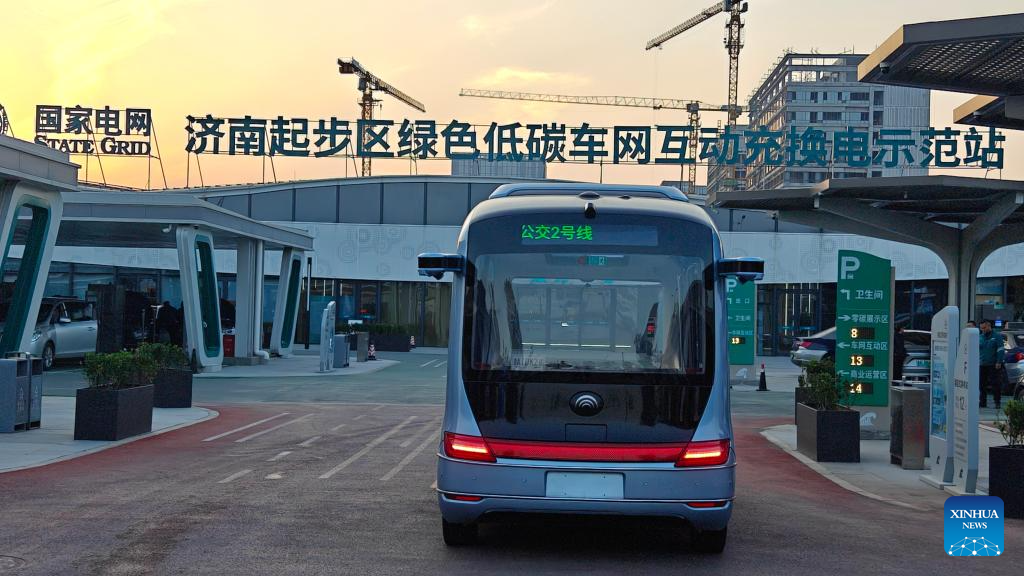Across China: China's autonomous buses lead the way to smarter urban mobility
Source: Xinhua
Editor: huaxia
2025-11-07 16:11:01

A self-driving bus runs on the Huanghe Avenue in the autonomous driving demonstration area of Jinan, east China's Shandong Province, on Nov. 4, 2025. (Xinhua/Xiao Haichuan)
JINAN, Nov. 7 (Xinhua) -- A quiet revolution is unfolding on the streets of Jinan, capital city of east China's Shandong Province. Ding Pingshun, a bus driver for 22 years, could be seen sitting in the back corner of a vehicle, holding a tablet instead of gripping a steering wheel.
"It feels quite peculiar to shift from being a driver of manned buses to a safety officer for autonomous ones," Ding remarked, as the self-driving bus glided along Huanghe Avenue in Jinan's autonomous driving demonstration area.
This bus, part of a pilot program by Jinan Public Transport Group, has been undergoing tests on a 6.4-kilometer route since June this year. The route includes traffic lights and pedestrian crossings -- and requires complex maneuvers like U-turns and lane changes. An onboard system displays real-time alerts, highlighting nearby objects in varying colors based on proximity.
Measuring 5.5 meters in length, this autonomous vehicle is equipped with nine seats and relies entirely on Chinese-made components, from its body to its control software. Sensors including HD cameras, lidar and radar enable it to navigate independently.
"So far, the bus has performed well, deciding on its own to detour or stop when encountering obstacles," Ding noted, emphasizing his role as a monitor rather than an active driver.
The test route is open to the public, with eight slots available for reservation on weekends. Families often book rides to experience this futuristic transport, blending daily life with cutting-edge technology.
Beyond road tests, the project integrates smart infrastructure. At a low-carbon green charging station, the bus autonomously parked at a V2G charger -- where a robotic arm, developed by State Grid's Jinan power supply company, inserted the plug in about 40 seconds.
Wang Shuai, deputy station head, explained: "Our self-developed arm uses pure vision recognition to identify vehicles, insert plugs accurately, and enable smart charging, thereby boosting efficiency through seamless automation."
Similar initiatives are spreading nationwide. In south China's Guangzhou, 19 autonomous minibuses began operating on five routes on Nov. 3, preparing for China's 15th National Games. Chengdu future sci-tech city in southwest China saw six-meter-long self-driving buses tested in May, alongside a white paper by Chengdu Bus Group on integrated vehicle-road-cloud systems. In central China's Wuhan, meanwhile, robotaxis crossed the Yangtze River via bridges last year, launching commercial inter-river services.
Experts hail 2025 as a pivotal year for smart city-vehicle synergy under the "vehicle-road-cloud integration" framework. They predict a rise in functional autonomous vehicles such as logistics and sanitation trucks, thus reshaping urban landscapes. ■

A self-driving bus drives into a charging station in Jinan, east China's Shandong Province, on Nov. 4, 2025. (Xinhua/Xiao Haichuan)

A robotic arm charges a self-driving bus at a charging station in Jinan, east China's Shandong Province, on Nov. 4, 2025. (Xinhua/Xiao Haichuan)

Ding Pingshun, a safety officer for autonomous bus, holding a tablet instead of gripping a steering wheel, works on the bus, in Jinan, east China's Shandong Province, on Nov. 4, 2025. (Xinhua/Xiao Haichuan)



